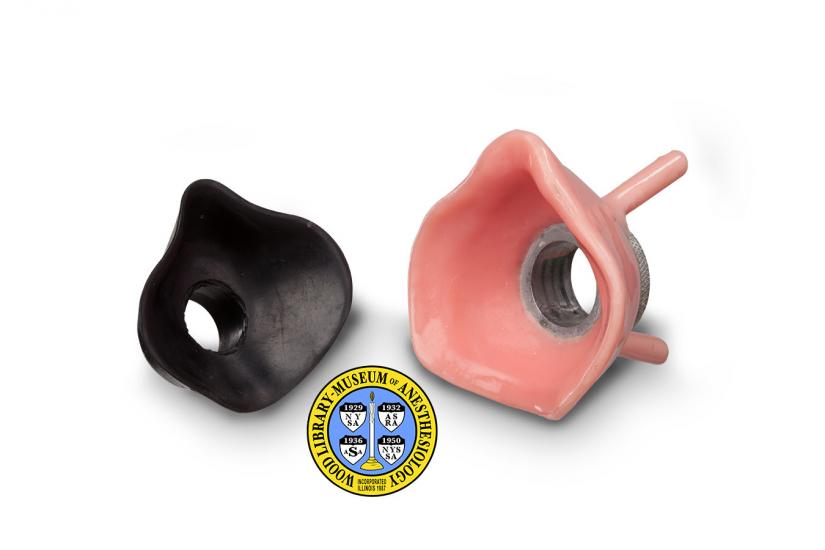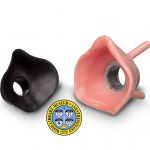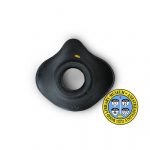Rendell-Baker & Soucek Mask
Throughout his career, Dr. Leslie Rendell-Baker (1917-2008) strove to improve standards in anesthesia education and equipment. He immigrated to the U. S. in 1957, where he worked at what is now Case Western Reserve University with Dr. Donald H. Soucek (1935-2010). Together, the two men designed a new pediatric anesthesia mask. Previously, such masks were scaled-down versions of adult masks, but the faces of infants and young children lack the prominent bones of adults. Ill-proportioned masks did not provide a good seal, and also left a space where carbon dioxide could build up.
Numerous molds were made of the faces of intubated young patients, using a layer of elastic material, which was then covered with plaster. These impressions were then cast in “dental stone” to make the models on which the experimental masks could be shaped. The pink wax mold shown on the right shows one stage in this process. The Rendell-Baker Soucek (RBS) Mask was introduced in 1961. At the same time, the inventors introduced a new adapter, designed to allow the mask to be used in closed circuit systems. The adapter separates the inhaled from the exhaled air and gas, acting as a non-rebreathing valve. By 1963 the mask was commercially available in three sizes for newborns and children up to ten years old.
Catalog Record: Rendell-Baker & Soucek Mask
Two Catalog Records: akwb and akwc
Access Key: akwb
Accession No.: 2013-09-16-2
Title: Rendell-Baker-Soucek mask / [designed by Leslie Rendell-Baker and Donand H. Soucek].
Author: Rendell-Baker, Leslie.
Author: Soucek, Donald H. (Henry), 1935-2010.
Title variation: Alt Title
Title: Rendell-Baker & Soucek mask.
Title variation: Alt Title
Title: Rendell-Baker Soucek mask.
Publisher: England : [Manufacturer not indicated], [between 1962 and 1985].
Physical Descript: 1 oronasal mask : rubber ; 6 x 7 x 3.5 cm.
Subject: Masks, Anesthesia.
Subject: Anesthesia, Pediatric – instrumentation.
Note Type: General
Notes: The early year in the range for the possible year of manufacture is based on
the year that Dr. Rendell-Baker and Soucek fist published about their mask.
The later year in the date range is an estimate based on discussion of the
material used for face masks in pediatric anesthesia texts such as Anesthesia
for Infants and Children by Robert M. Smith. By 1980 black rubber masks were
already being replaced by clear plastic masks. The date range could change if
documentation indicates that it should be corrected.
Note Type: General
Notes: The title is based on the most common form of the name as found in a google
books search. Search performed on October 20, 2014.
Note Type: General
Notes: The mask may have been made by J. G. Franklin & Sons, Ltd. This is the
manufacturer described in the 1962 article.
Note Type: Citation
Notes: Fiadjoe JE, Feldman JM, Cohen DE. Equipment. In: Davis PJ, Cladis FP,
Motoyama EK, eds. Smith’s Anesthesia for Infants and Children. 8th ed.
Philadelphia: Elsevier/Mosby; 2011:303.
Note Type: Citation
Notes: Rendell-Baker L, Calverley RK. Memorandum of conversation. February 10,
1993:23-25. Leslie Rendell Baker biographical file. Located at : Wood Library
Museumof Anesthesiology, Schaumburg, Illinois.
Note Type: Citation
Notes: Rendell-Baker L. Curriculum vitae. Leslie Rendell Baker biographical file.
Located at : Wood Library Museumof Anesthesiology, Schaumburg, Illinois.
Note Type: Citation
Notes: Rendell-Baker L. Rendell-Baker-Soucek Mask. In: Maltby JR, ed. Notable Names
in Anaesthesia. London: Royal Society of Medicine Press Ltd.; 2002:173-175.
Note Type: Citation
Notes: Rendell-Baker L, Soucek DH. New paediatric face masks and anaesthetic
equipment. Br Med J. June 16, 1962;1(5293):1690. https://www.ncbi.nlm.nih.
gov/pmc/articles/PMC1958835/. Accessed October 21, 2014.
Note Type: Citation
Notes: Soucek DH, Rendell-Baker L. The design of experimental latex paediatric face
masks in 1961. In: Atkinson RS, Boulton TB, eds. The History of Anaesthesia.
London: Royal Society of Medicine Services; 1989:328-333.
Note Type: Citation
Notes: Steven JM, Cohen DE. Anesthesia equipment and monitoring. In: Motoyama EK, ed
Smith’s Anesthesia for Infants and Children. St. Louis: C.V. Mosby Company;
1990:224.
Note Type: Physical Description
Notes: One small black rubber oronasal mask measuring approximately 6 cm in height,
6.6 cm wide, and 3.5 cm deep (these measurements are based on the patient’s
perspective; The mask is shaped to conform to the flatter face of pediatric
patients; At the distal end is the opening to connect to a valve or tubing
conecctor; the opening is approximately 2 cm in diameter; the rubber is in
good condition; on the lower, exterior side of the mask are some manufacturer
markings, “RENDELL-BAKER [new line] SOUCEK MASK [new line] MADE IN [a number
“1” inside a circle] ENGLAND”.
Note Type: Reproduction
Notes: Photographed by Mr. Steve Donisch, in September, 2013.
Note Type: Acquisition
Notes: Donated to the WLM by Linda A. Lutz, MD.
Note Type: Historical
Notes: This pediatric oronasal mask was designed by Dr. Leslie Rendell-Baker
(1917-2008) and Dr. Donald H. Soucek (1935-2010) in 1961 at Western Reserve
University School of Medicine in Cleveland, Ohio. At that time, Dr.
Rendell-Baker was an assistant professor of anesthesiology and Dr. Soucek a
resident in dental surgery.
Their work was motivated by dissatisfaction with the pediatric anesthesia
masks available to them. Masks for infants and children tended to be smaller
versions of adult anesthesia masks. The proportions were not right and most
masks did not easily conform to a child’s face. This resulted in a poor seal
that allowed anesthetic gas to leak into the operating room. Also, because
more room is needed for an adult’s nose, the early masks for children had a
large space for carbon dioxide (CO2) to accumulate. The volume of air that a
child breathes in and out is small, so even a small space where CO2
accumulates can be a significant proportion of the air a child inhales. This
can lead to an unhealthy build-up of CO2 in a child’s body as well as an
inadequate amount of oxygen reaching a child’s lungs.
To design a better pediatric anesthesia mask, Dr. Rendell-Baker and Dr.
Soucek used techniques that were employed in dentistry to create detailed and
accurate casts of the mouth and gums. They began by taking facial impressions
or molds, of children from a variety of ages and ethnic and racial groups.
The molds were used to shape models of masks from a pink wax that is hard at
room temperature but malleable when warmed above 99 °F. Working prototypes of
black rubber were made from the wax models. The prototypes were then used to
study the shapes that produced the best fit.
The final design resulted in a mask that had little space for CO2 to
accumulate, and malleable sides which conformed well to the shape a child’s
face. Introduced in 1961, the new mask was first manufactured in England by J
G. Franklin & Sons in two sizes: No. 1 for infants from birth to 1 year of
age, and No. 2 for children 1 to 3 years of age. More sizes soon followed.
With the mask they introduced an adaptor that allowed the mask to be used
with different anesthesia breathing systems. It did not take long for the
Rendell-Baker-Soucek mask and adaptor to become widely adopted, and although
no longer the most popular anesthesia mask, it remains an important option to
this day.
That a British manufacturer was chosen may have something to do with the fact
that Dr. Rendell-Baker was born in the UK and administered anesthesia there,
first as a medical student, then as a graduate and finally as an anaesthetist
from 1939 to 1957. He immigrated to the US in 1957 after spending a year as
a Fulbright assistant professor in Pittsburgh. While at Case Western, from
1957-1962, Dr. Rendell-Baker became involved in developing standards for
anesthesia equipment. This was the start of his significant involvement and
leadership in establishing standards in anesthesia equipment. His
contributions helped to improve the safety and quality of anesthesia care.
Note Type: Exhibition
Notes: Selected for the WLM website.
Access Key: akwc
Accession No.: 2013-09-16-1
Title: [Model of a Rendell-Baker-Soucek mask / designed by Leslie Rendell-Baker and Donald H. Soucek].
Author: Rendell-Baker, Leslie.
Author: Soucek, Donald H. (Henry), 1935-2010.
Title variation: Alt Title
Title: Rendell-Baker Soucek mask prototype.
Publisher: [1961?]
Physical Descript: 1 oronasal mask : hard wax, metal : 7.5 x 7.5 x 6.5 cm.
Subject: Masks, Anesthesia.
Subject: Anesthesia, Pediatric – instrumentation.
Subject: Prototypes.
Note Type: General
Notes: The date range for the possible year of creation is an estimate based on an
article written by Dr. Soucek and Dr. Rendell-Baker in the 1987 publication
of the proceedings of the Second International Symposium on the history of
anaesthesia, titled, “The History of Anaesthesia”.
Note Type: General
Notes: The title is based on the most common form of the name as found in a google
books search. Search performed on October 20, 2014.
Note Type: With
Notes: In a plastic bag with a white label that has a hand-written note, “MASK
modelled in HARD WAX for preparation of MOLD, SIze 2, Note – very fragile.”
Note Type: Citation
Notes: Fiadjoe JE, Feldman JM, Cohen DE. Equipment. In: Davis PJ, Cladis FP,
Motoyama EK, eds. Smith’s Anesthesia for Infants and Children. 8th ed.
Philadelphia: Elsevier/Mosby; 2011:303.
Note Type: Citation
Notes: Rendell-Baker L, Calverley RK. Memorandum of conversation. February 10,
1993:23-25. Leslie Rendell Baker biographical file. Located at : Wood Library
Museumof Anesthesiology, Schaumburg, Illinois.
Note Type: Citation
Notes: Rendell-Baker L. Curriculum vitae. Leslie Rendell Baker biographical file.
Located at : Wood Library Museumof Anesthesiology, Schaumburg, Illinois.
Note Type: Citation
Notes: Rendell-Baker L. Rendell-Baker-Coucek Mask. In: Maltby JR, ed. Notable Names
in Anaesthesia. London: Royal Society of Medicine Press Ltd.; 2002:173-175.
Note Type: Citation
Notes: Rendell-Baker L, Soucek DH. New paediatric face masks and anaesthetic
equipment. Br Med J. June 16, 1962;1(5293):1690. https://www.ncbi.nlm.nih.
gov/pmc/articles/PMC1958835/. Accessed October 21, 2014.
Note Type: Citation
Notes: Soucek DH, Rendell-Baker L. The design of experimental latex paediatric face
masks in 1961. In: Atkinson RS, Boulton TB, eds. The History of Anaesthesia.
London: Royal Society of Medicine Services; 1989:328-333.
Note Type: Citation
Notes: Steven JM, Cohen DE. Anesthesia equipment and monitoring. In: Motoyama EK, ed
Smith’s Anesthesia for Infants and Children. St. Louis: C.V. Mosby Company;
1990:224.
Note Type: Physical Description
Notes: One prototype or model of a pediatric oronasal mask; It is composed of hard
pink wax and a metal connection for a valve or a tubing connector; Two thin
cylindrical stems extend distally from above and below the metal connection;
They each measure approximately .8 cm in diameter and 3 cm in length; The
upper stem is a bit shorter than the lower; There are now markings on the
prototype.
Note Type: Reproduction
Notes: Photographed by Mr. Steve Donisch, in September, 2013.
Note Type: Historical
Notes: This pediatric oronasal mask was designed by Dr. Leslie Rendell-Baker
(1917-2008) and Dr. Donald H. Soucek (1935-2010) in 1961 at Western Reserve
University School of Medicine in Cleveland, Ohio. At that time, Dr.
Rendell-Baker was an assistant professor of anesthesiology and Dr. Soucek a
resident in dental surgery.
Their work was motivated by dissatisfaction with the pediatric anesthesia
masks available to them. Masks for infants and children tended to be smaller
versions of adult anesthesia masks. The proportions were not right and most
masks did not easily conform to a child’s face. This resulted in a poor seal
that allowed anesthetic gas to leak into the operating room. Also, because
more room is needed for an adult’s nose, the early masks for children had a
large space for carbon dioxide (CO2) to accumulate. The volume of air that a
child breathes in and out is small, so even a small space where CO2
accumulates can be a significant proportion of the air a child inhales. This
can lead to an unhealthy build-up of CO2 in a child’s body as well as an
inadequate amount of oxygen reaching a child’s lungs.
To design a better pediatric anesthesia mask, Dr. Rendell-Baker and Dr.
Soucek used techniques that were employed in dentistry to create detailed and
accurate casts of the mouth and gums. They began by taking facial impressions
or molds, of children from a variety of ages and ethnic and racial groups.
The molds were used to shape models of masks from a pink wax that is hard at
room temperature but malleable when warmed above 99 °F. The wax model
described here is an example. Working prototypes of black rubber were made
from the wax models. The prototypes were then used to study the shapes that
produced the best fit.
The final design resulted in a mask that had little space for CO2 to
accumulate, and malleable sides which conformed well to the shape a child’s
face. Introduced in 1961, the new mask was first manufactured in England by J
G. Franklin & Sons in two sizes: No. 1 for infants from birth to 1 year of
age, and No. 2 for children 1 to 3 years of age. More sizes soon followed.
With the mask they introduced an adaptor that allowed the mask to be used
with different anesthesia breathing systems. It did not take long for the
Rendell-Baker-Soucek mask and adaptor to become widely adopted, and although
no longer the most popular anesthesia mask, it remains an important option to
this day.
That a British manufacturer was chosen may have something to do with the fact
that Dr. Rendell-Baker was born in the UK and administered anesthesia there,
first as a medical student, then as a graduate and finally as an anaesthetist
from 1939 to 1957. He immigrated to the US in 1957 after spending a year as
a Fulbright assistant professor in Pittsburgh. While at Case Western, from
1957-1962, Dr. Rendell-Baker became involved in developing standards for
anesthesia equipment. This was the start of his significant involvement and
leadership in establishing standards in anesthesia equipment. His
contributions helped to improve the safety and quality of anesthesia care.
Note Type: Exhibition
Notes: Selected for the WLM website.



